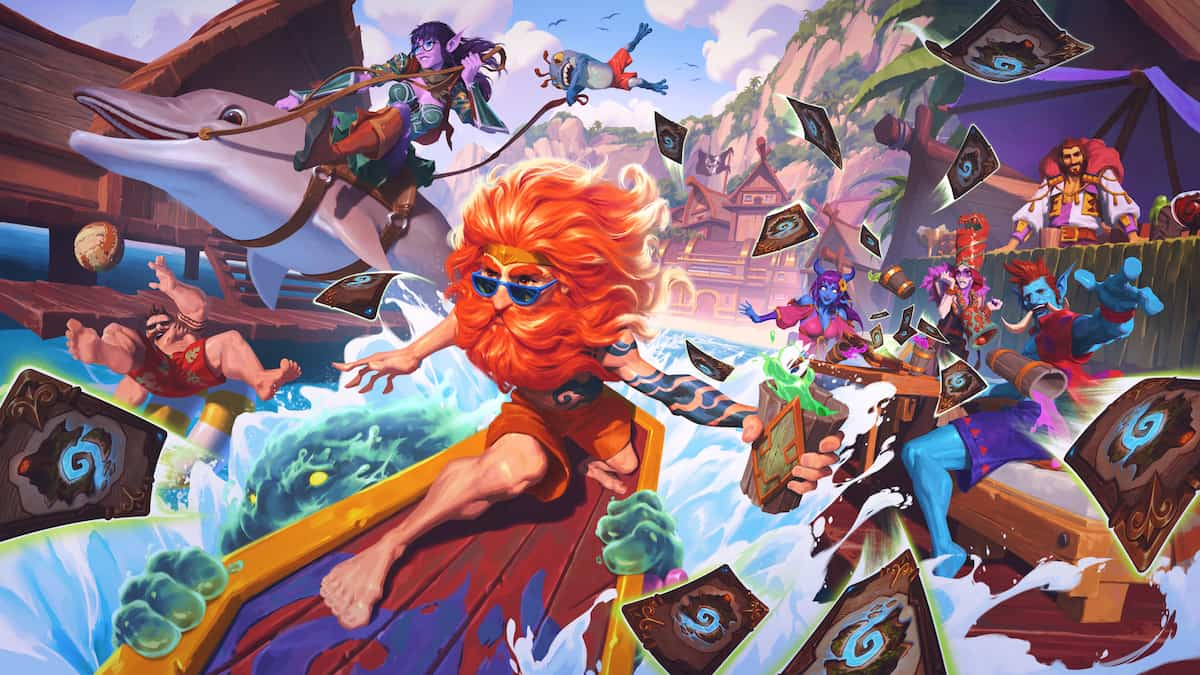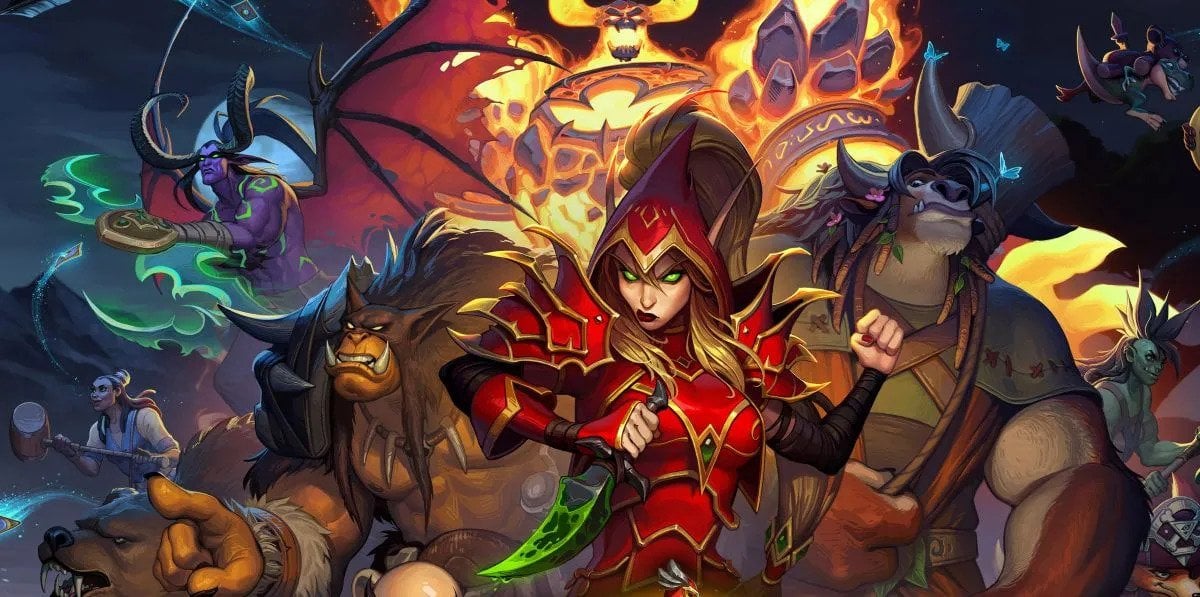Hello and welcome to yet another Flavor Text and Lore article. Stay a while… And read about the story and lore behind Hearthstone’s first adventure, its bosses and most notable cards.
Naxxramas was the final hurrah for the original World of Warcraft before the “The Burning Crusade” expansion was launched.
Here was a final epic challenge, a dungeon meant to be tackled by a team of forty top-level players with bosses so tough that merely standing a chance against them required the players to have completed and acquired the gear from the previous two raid-tier dungeons, Blackwing Lair and Temple of Ahn’qiraj.
It was not only Blizzard’s most challenging dungeon, but also its largest ever, with five distinct areas and fifteen bosses bosses. It was World of Warcraft leaving its original release and going into its first expansion in a blaze of glory.
And only a minuscule percentage of the player base got to experience it.
In the Shadow of the Necropolis
Naxxramas itself is a flying citadel, the seat of the Lich King’s power in the continent of Azeroth.

As the Lich King was imperiled by the demon hunter illidan-stormrage he called his most powerful servant, the death knight and fallen prince of Lordaeron, Arthas Menethil, to defend him – and the arch-lich kelthuzad was left in Azeroth to protect the Lich King’s conquest from the rebellious acts of sylvanas-windrunner.
But the lich failed, and was forced to flee to the east. From then on, Naxxramas floated atop the ruined Plaguelands, fighting a bloody tug-of-war with Sylvanas’ Forsaken and the humans of the Scarlet Crusade for possession of the decaying lands, a constant struggle that remained stalled for well over a decade.
World of Warcraft’s patch 1.11, titled “Shadow of the Necropolis” was supposed to bring that narrative arc to a close, the player’s victory over the Necropolis and its resident abominations being the turning point in the ongoing battle against the Lich King’s undead Scourge

And it was, but with a couple of important caveats: first, the player characters, upon defeating the arch-lich kelthuzad found themselves oddly compelled to deliver his phylactery – the source of his immortality – to a shady priest, instead of destroying it on the spot.
And then, there was the matter of, despite the narrative having officially been brought to a close, few players experienced the dungeon, so great were the entry requirements, and so hard was the challenge.
So, Blizzard decided to repurpose it as the entry-level raid dungeon for their third expansion, “Wrath of the Lich King”.
Northrend’s First Line of Defense
In World of Warcraft’s third expansion, the players saw themselves tasked with assaulting the northern continent of Azeroth, Northrend, in a bid to stop the Lich King’s armies before they were unleashed upon the lands of the living once more.

The front line turned out to be the icy wastes of the Dragonblight, the harsh, inhospitable land where Arthas originally found the cursed runeblade Frostmourne.
And Naxxramas could be found overseeing the Lich King’s defenses, floating atop this new battlefield. The story reason for this is somewhat unclear, but what is hinted at is that, after the players defeated kelthuzad in the Eastern Plaguelands, the necropolis retreated back to Northrend, where it stood recovering and rebuilding up until its master’s phylactery was recovered and the arch lich, risen once more.
Again, there is a fair bit of obscuring on Blizzard’s part when it comes to this part of the lore, and that is most likely because all bosses bar one are reused, and not all could be as neatly resurrected as kelthuzad. At the very least, “living” opponents like Grand Widow Faerlina or maexxna should now be undead versions of the originals, but this was not the case.
Regardless, this new version was a triumph of content, introducing a much more flexible approach to raiding, with two difficulty modes – one for 10 players, other for 25 players – and so, was completed and appreciated by a much larger fraction of the player base than the original version.

As a side note, since the original Naxxramas was removed from the “old world”, but the gear obtainable by the players in the new version had different colors from the one obtained in the original, the original Naxxramas’ armor pieces are now some of the rarest and most coveted in-game, only being randomly obtainable through Blizzard’s “black market” auction house and often going for hundreds of thousands of gold, as players fiercely outbid one another for them.
A Lighter Shade of Undeath
Something that may not be so obvious to people who have not experienced the World of Warcraft / Wrath of the Lich King content is how different the tone of the Hearthstone version is.

Blizzard’s MMO is as sprawling in narrative terms as it is spatially: you can find tales of romance, a lot of comedy and pop references, stories of heroism, grimdark sagas and everything in between. The Lich King’s storyline, though, is up there with the darkest. The original Naxxramas, then, was not a happy place. Not at all.
It was a story of people battling insurmountable odds and ancient evils that revelled in the suffering and slaughter of foe and innocent alike. Readers interested in sampling some of the original tone would do well to read kelthuzad’s origin story, “Road to Damnation”, by Evelyn Fredericksen, made freely available by Blizzard on the official World of Warcraft website.
Hearthstone’s adventure, then, provides a stark contrast to the original, retrofitting it with a lighter, almost cartoon-like villainous tone. The bosses may be evil and out to get you, but most of them also seem to be enjoying themselves. They are, after all, playing a card game – the Adventure recognizes this and occasionally breaks the fourth wall, kelthuzad openly cheating.
The Arachnid Quarter
The Arachnid Quarter houses Naxxramas’ original inhabitants, the Nerubians. The ancient spider-like race had long made their home deep inside the tunnel networks that ran below the lands of Northrend. There they built a respectable civilization.

Once the Lich King turned his dark gaze upon them, though, in his bid to forever increase his power, the Nerubian kingdom quickly fell, most of their people enslaved in either life or death, and their architectural marvels – Naxxramas being the most obvious example – co-opted to serve the Scourge war machine.
The first boss of the Arachnid Quarter, Anub’Rekhan, is one such victim, once a king to the Nerubians, now simply a powerful slave to the necromancer.
While the Arachnid’s quarter most significant impact in Hearthstone has no doubt been both nerubian-egg and haunted-creeper, there are no “clean” equivalents to them in the World of Warcraft raid. They are more based around the Arachnid Quarter’s general theme. For example, during the fight with maexxna, the players are often swarmed by tiny, seemingly endless spiderlings, something that could be argued to have been the inspiration for the haunter-creeper.
The Plague Quarter
The Plague is the means by which the Lich King builds most of his armies – a noxious substance, usually in liquid form, that turns living beings into mindless undead.

While the player race of the Forsaken has been known to tamper with it for their own purposes, it is here, in the heart of Naxxramas, that the Lich King’s most prominent necromancers and alchemists work to increase its potency.
The Plague Quarter’s most noteworthy resident is Heigan the Unclean, mostly due to his boss mechanics. At a certain point in the fight, he would teleport to a raised dais and trigger traps where the players stood, in such a way that they had to keep moving or be sure to die.
The pattern that such movement described became known as “the Heigan dance”, and stands to this day as an example of the importance of proper, coordinated movement in World of Warcraft encounters. The Hearthstone boss encounter gives this a nod via Heigan’s Hero Power, casting an eruption that damages the left-most minions – the one poor minion that had poor dancing skills.

Once again, there are but a few similarities between the creatures found in the Plague Quarter and the respective Hearthstone cards – unless you count stoneskin-gargoyle, but who cares about that?
The most popular card from this quarter is especially not faithful to the original encounter: loatheb never made it harder for players to cast their spells. What it was known for was for preventing healing and progressively damaging the raid, thus resulting in a very tense battle.
The Military Quarter
This is where the finest fighters of the Scourge are forged, chief among them the Death Knights that were not freed from the Lich King’s dominion by tirion-fordring and the ashbringer (you can read all about it in the Paladin’s Flavor Text and Lore article ).

In Hearthstone as in the original World of Warcraft raid, this area is mostly unremarkable, apart from the very last fight, where the players are confronted by the Four Horsemen, led by baron-rivendare. The Baron is the only “new” boss in the revamped dungeon, having been repurposed from his role in a lesser, classic dungeon.
Here he sits in replacement of the original leader of the death knights, Alexandros Mograine, who once wielded the corrupted ashbringer before it was retrieved by his son and purified by tirion-fordring.
baron-rivendare is mostly known among World of Warcraft players for his skeletal horse. When killing him (not in Naxxramas but in his earlier incarnation) there is a very slight chance that he will drop the reins of his mount, that being the only chance for Alliance characters to ride an undead horse (the Forsaken’s standard mount).
The Construct Quarter
Possibly the least lore-rich of the Quarters, the Construct Quarter is the assembly line for the frankenstein-like mishmashes of limbs that serve as the Scourge’s heavy units. There isn’t a lot of charisma or lore behind these abominations, though the fight with the Gluth boss did provide Blizzard with the inspiration for one of Hearthstone’s most popular one-drops, zombie-chow.

The fight against the dog-like abomination Gluth was a more or less conventional one, but the differentiating factor was that every now and then he would get hungry and devour a nearby zombie-chow, healing himself.
The zombie-chow kept coming, and were way more resilient that the average zombie, so in addition to battling Gluth, the players needed to also draw the Zombies away from him while they finished them.
Frostwyrm Lair
The Frostwyrm Lair is the central cortex of the Necropolis’ nervous system, housing both the Arch-Lich kelthuzad and his guardian, the frost wyrm Sapphiron.

One a powerful servant of malygos, the Master of Magic, Sapphiron was a blue dragon that dwelled in Northrend for hundreds of years, guarding a treasure trove of powerful artifacts in his Master’s behalf.
But as the ripples resulting from the end of the Third War drove illidan-stormrage to travel to Northrend in an attempt to confront and destroy the Lich King, so was the Death Knight Arthas summoned to protect his master from the wrath of the demon-hunter.
And upon arriving in Northrend and meeting his Nerubian allies, Arthas was promptly informed about the Blue Dragon’s magical cache, and made plans to steal it so that the artifacts would grant him an edge over Illidan.

After the fierce battle and the extermination of the blue dragons, Arthas recognized Sapphiron as a powerful foe – and, as was his way, he used his remaining powers to revive the Dragon into an undead distortion of his former self – subservient, as always, to Arthas and his master.
And so it is that Sapphiron now stands as guard to kelthuzad’s inner sanctum. His front breath alone can wipe out an entire group of players – the only protection from it being the act of hiding behind some unlucky players that the wyrm had previously freezed, a concept that was suitably adapted for the Hearthstone Adventure boss encounter.
But what about the master of Naxxramas himself, the dreaded arch-lich kelthuzad ?

He was a prominent mage from the city-state of Dalaran, once seduced by the Lich King’s promises of power, only to later become little more than a thrall to the mighty necromancer.
As mentioned above, the tale of his origin and downfall, “Road to Damnation”, by Evelyn Fredericksen, can be read on the official World of Warcraft website, so there is little point to me reiterating that story here.
After his enslavement by the Lich King, he was allowed to remain among the living, apprenticed in the arts of necromancy and able to covertly act in the human lands. There, kelthuzad worked to undermine belief in the Holy Light and formed the Cult of the Damned, a cabal of necromancers that believed the Lich King to be their way towards the power and respect they craved.

It was through this cult that kelthuzad succeeded in unleashing the undead plague that ignited the Third War in Warcraft III. The necromancer later met his death at the hands of prince Arthas, only to be soon resurrected in his final, lich form, by the prince again, now himself a servant of the Lich King.
From then on, kelthuzad faithfully assisted Arthas as his second-in-command, through the summoning of Archimonde and the Legion, sylvanas-windrunner’s rebellion, and finally, as his general in the Eastern Kingdoms when the Death Knight fused with the Lich King into a single, god-like entity.
Now, he sits on his throne at the top of Naxxramas, plotting ever more cunning ways of serving his icy lord.
A cruel, ruthless opponent, his Hearthstone persona is considerably more playful – even if he is a dirty cheater.
Conclusion
I hope you enjoyed this new journey into the Lore of the first Hearthstone adventure.
Next up are the Blackrock Depths and Molten Core – let me know in the comments if you enjoyed this format, or if you’d rather have me focusing on some other aspects.





Published: Feb 6, 2016 09:14 am